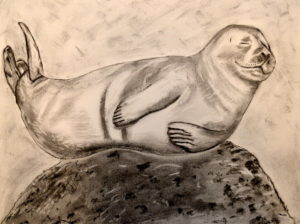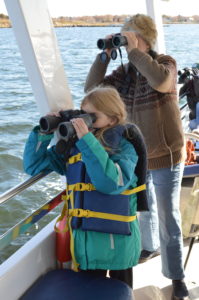Save the Bay Cruises for Wildlife

A Harbor seal strikes the “Happy Banana” pose. Charcoal by Hugh Markey.
It’s November, and it feels like it. Though it’s sunny and the wind is calm, aboard Save the Bay’s educational vessel Elizabeth Morris, the passengers wisely left their boat shoes and shorts at home and wore winter coats and hats instead. Perched on a rock in the Pawcatuck River is a Harbor seal. The first-year plump, gray animal is happily ignorant of the chilly temperatures, lying on its side with head and tail raised. The young male’s eyes are closed, blissfully soaking up the sun. This youngster is alone, which is a trifle unusual for seals.
On this day, the Morris is hosting ten passengers on a nature cruise, which Save the Bay (STB) offers on Saturdays from October through December. Each 90-minute voyage provides visitors with both a natural and historical narrative of the river that separates this section of Rhode Island from Connecticut. Katie Maginel, captain of the Morris, says that this is the third year STB has taken passengers out. A similar program has sailed from Newport for the past 15 years. “People love them!” she says.
Happy Banana
“We like to call that the ‘happy banana’ pose,” said Dr. Allison Tuttle, veterinarian and director of the Animal Rescue Program at Mystic Aquarium. It seems to be the perfect description for the seal, which seems peacefully oblivious to our presence. Maginel keeps the boat at a safe distance in order to ensure that the animal stays just as relaxed as it currently is.
Tuttle is aboard the Morris as a guest commentator for the day’s Save the Bay nature cruise. She sees many Harbor seals come through her program, and says that the species is the most commonly spotted around Rhode Island’s shoreline as well as the one most often rescued. “There are lots of reasons a seal may need to be rescued,” she explains to the passengers. “Sometimes the mother may abandon her pup if it feels threatened. In other cases, the seal may be sick, or perhaps has been injured by a shark bite or even a bite from another seal. They are also sometimes injured by being tangled in fishing gear.” Tuttle says Mystic rescues an average of 30 – 35 seals each year. In addition to Harbor seals, Rhode Island waters may be visited by Gray, Harp and Hooded seals, the latter two being a rare sight.

18,000 Kids
Ally Karaczynski, education specialist with Save the Bay, tells the group that the organization works with 18,000 kids a year in its education program. “The proceeds from paid trips like this one allow us to get kids on the water who may not normally be able to,” she explains. “A lot of the kids we serve are from the inner cities, and learning about the marine environment is really something new for them.” She also notes that STB’s paid memberships help support educational programs as well.
Karaczynski’s job on this trip is to provide information on the region of the Pawcatuck, which has been settled since the 1600’s. She points out an assortment of land areas of historical significance, along with marshes that comprise an important part of the ecosystem.
On the rocks and in the air
A bit farther along, someone points to a group of rocks exposed from the low tide. What at first seems like gray rocks atop gray rocks soon turns out to be a pod of five more Harbor seals. Once again, each animal seems relaxed and happy in the sunshine. Several of them pause their sunbathing to turn their gaze at this strange floating object in front of them. It’s hard not to wonder what may be going through their minds at that moment. Whatever it is, they seem to recognize that our crew bear them no ill intent, and they continue to bask where they are. Dr. Tuttle says that four of them appear to be youngsters, with a larger, older one sprawled out on a much longer rock.

A Great Blue Heron along the Pawcatuck.
“A sight like that is especially good,” she says, “because it shows that the Pawcatuck is both a pristine river and one that is protected. It’s a healthy environment for them because the river supports a lot of food.”
As the boat is nearly back to the dock, there is a commotion in a riverbank tree. A flock of crows is considerably upset, taking turns diving at a large animal on one of the branches. With a great wave of its wings, the bird hops off its perch and begins to fly across the sky before the bow of the boat. It’s a juvenile Bald Eagle, an animal that has been making a comeback in Rhode Island.

A juvenile Bald Eagle crosses the bow of the boat.
Although it is at least three times the size of the crows, they continue their attack as the eagle bobs and weaves its way across the river. This too is a sign of a pristine environment, where the eagle, primarily a fish eater, appears in increasing numbers, much to the delight of the Save the Bay Nature Cruise voyagers.
For more information about Save the Bay’s cruises, visit www.savebay.org/seals , or call 401-272-3540.






